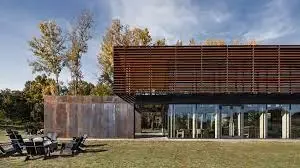1. Introduction: Exploring Norwegian Architecture

In Scandinavia, where stunning natural beauty meets modern design, Norwegian architecture is a fascinating blend of old and new sculptures. Situated amidst fords, mountains, and forests, Norwegian architecture reflects the country's rich history, strong connection to nature, and commitment to being eco-friendly and innovative.
From ancient wooden churches from Viking times to contemporary city buildings that redefine city skylines, This architecture is the product of combining tradition and progress. In this journey, we will uncover the unique characteristics, influences, and ideas that have shaped Norway's architectural landscape into a global hub for impressive designs.
Let's take a closer look at Norwegian architecture, from its historical origins to its global impact, all while celebrating the enduring influence of nature on its distinctive style. Get ready to be inspired by a captivating mix of old and new, which defines what Norwegian architecture is all about.
2. Historical Influence in Norwegian Architecture
In the 19th century, the National Romantic movement celebrated Norway's unique cultural identity, emphasizing elements from folklore and Viking history. This influence can be seen in grand buildings like the Oslo City Hall.
Furthermore, the 20th century brought modernist ideas to Norway, mixing international modernism with elements of Scandinavian simplicity and functionality. All these historical layers have contributed to the diverse and distinctive landscape of Norwegian architecture.
3.Modern Architectural Icons of Norway
Norway boasts several modern architectural icons that have garnered international acclaim. Among them, the Oslo Opera House stands out as a remarkable masterpiece. Designed to look like an iceberg rising from the Oslo Fjord, this mesmerizing structure is not only an opera house but also a public space where visitors can walk on its sloping roof for panoramic views of the city.
The Trollstigen Visitor Center, nestled in the dramatic landscape of the Trollstigen mountain pass, is a striking example of contemporary Norwegian architecture. Its bold design integrates with the natural surroundings, offering visitors an immersive experience in this breathtaking location.
These architectural icons of Norway represent a harmonious blend of modern design principles and a deep respect for the country's natural beauty, making them not only visually captivating but also culturally significant.
4. The Scandinavian Design Aesthetics
Scandinavian design is characterized by simplicity, minimalism, and functionality. It emphasizes clean lines, neutral colors, and the use of natural materials like wood and stone. Functionality and practicality are at the core of this design philosophy, with an emphasis on creating objects and spaces that are both aesthetically pleasing and highly functional.
This design aesthetic also places a strong focus on sustainability and eco-friendliness, with a commitment to using renewable resources and reducing waste. It often incorporates elements of nature and seeks to bring the outdoors inside, creating a sense of harmony with the environment.
Scandinavian design has had a profound influence on various fields, including architecture, interior design, and product design, and it continues to be celebrated for its timeless elegance and simplicity.
5. Sustainability in Norwegian Architecture
6. Innovative Use of Materials
Norwegian architects creatively blend traditional and new materials to construct their buildings. They make use of natural resources like wood and stone alongside innovative materials, resulting in unique and sustainable designs. This combination of old and new materials adds character to their structures and showcases a commitment to both tradition and innovation in architecture.
7. Architectural Firms and Designs
In Norway, there are architectural companies and designers who are known for their exceptional work. They create impressive buildings and spaces that blend beauty with functionality. These firms and designers play a vital role in shaping the country's modern architectural landscape and are recognized for their unique and influential contributions to the field.
8. Urban Planning and Cityscapes
Norway's urban planning and cityscapes reflect a thoughtful balance between modernity and nature. Cities like Oslo seamlessly blend contemporary architecture into their landscapes while preserving green spaces and waterfronts. Pedestrian-friendly streets, efficient public transport, and sustainable urban development are hallmarks of Norwegian cities. This approach not only creates visually appealing cityscapes but also promotes a high quality of life for residents, emphasizing the importance of both urban living and natural beauty.
9. The Role of Nature in Design
In Norwegian design, nature plays a central and inspiring role. Architects and designers often draw inspiration from Norway's breathtaking landscapes, including fjords, mountains, and forests. They incorporate natural elements into their creations, such as using wood and stone in building materials or designing spaces that offer panoramic views of the surrounding environment.
This deep connection to nature also extends to sustainability. Norwegian designers prioritize eco-friendly practices and seek to minimize the impact of their projects on the environment. In essence, the role of nature in Norwegian design is to provide not only aesthetic inspiration but also a profound commitment to harmonizing human-made structures with the natural world, creating a sense of unity and serenity in the built environment.
10. Public Art and Architecture
In Norway, public art and architecture often intertwine to create immersive and culturally significant spaces. Architects collaborate with artists to incorporate sculptures, installations, and murals into their designs. This integration of art enhances the aesthetics of public spaces, fosters a sense of community, and tells stories about Norway's culture and history.
Public art and architecture projects often serve as landmarks and meeting points within cities, contributing to a vibrant urban landscape. They also reflect Norway's commitment to making art and culture accessible to all, reinforcing the idea that beauty and creativity should be integral to daily life.
11. Challenges and Future Trends
- One challenge facing Norwegian architects is adapting to a changing climate and designing buildings that can withstand extreme weather conditions.
- Balancing the preservation of the natural environment with urban development is still a challenge, as Norway values its pristine landscapes.
- Affordable housing shortages in cities require innovative solutions in design and urban planning.
- Striking a balance between modern design and preserving historical heritage can be challenging in a rapidly evolving architectural landscape.
- Sustainable architecture will continue to be a dominant trend, with a focus on energy-efficient buildings and eco-friendly materials.
- Smart and technology-integrated design will play a growing role in enhancing living experiences.
- Innovative approaches to urban planning will prioritize walkable, green, and community-centric cities.
- Embracing cultural diversity and inclusivity in design will shape the future of Norwegian architecture, reflecting evolving societal values.
12. Conclusion
Conclusion: Celebrating the Essence of Norwegian Architecture
Norwegian architecture embodies a captivating journey through time, seamlessly blending tradition with modernity, and harmonizing human creations with the awe-inspiring natural landscapes that define this Nordic wonderland. From historical influences that trace their roots to Viking heritage to the timeless principles of Scandinavian design, Norway's architectural identity is a unique fusion of heritage and innovation.
Its commitment to sustainability, innovative use of materials, and a flourishing community of architectural firms and designers make Norway a global leader in the field. Its urban planning and cityscapes prioritize both functionality and aesthetics, enriching the lives of its inhabitants.
The profound influence of nature on Norwegian design, along with the integration of public art, exemplifies a commitment to enriching daily life with beauty and cultural significance. As challenges like climate change and affordable housing persist, Norwegian architects will continue to innovate, shaping the future with sustainable, smart, and inclusive designs.
In essence, Norwegian architecture celebrates beauty, functionality, and the enduring connection between human creativity and the stunning natural world surrounding it. It stands as a testament to Norway's rich cultural heritage and its unwavering dedication to creating spaces that inspire and endure.









